Easy Way to Get My Key Switch Working on My 2004 Toro 147 Zmaster
Note: Determine the left and right sides of the machine from the normal operating position.
Adding Fuel
-
For best results, use only clean, fresh (less than 30 days old), unleaded gasoline with an octane rating of 87 or higher ((R+M)/2 rating method).
-
Ethanol: Gasoline with up to 10% ethanol (gasohol) or 15% MTBE (methyl tertiary butyl ether) by volume is acceptable. Ethanol and MTBE are not the same. Gasoline with 15% ethanol (E15) by volume is not approved for use. Never use gasoline that contains more than 10% ethanol by volume, such as E15 (contains 15% ethanol), E20 (contains 20% ethanol), or E85 (contains up to 85% ethanol ). Using unapproved gasoline may cause performance problems and/or engine damage which may not be covered under warranty.
-
Do not use gasoline containing methanol.
-
Do not store fuel either in the fuel tank or fuel containers over the winter unless a fuel stabilizer is used.
-
Do not add oil to gasoline.
Danger
In certain conditions, gasoline is extremely flammable and highly explosive. A fire or explosion from gasoline can burn you and others and can damage property.
-
Fill the fuel tank outdoors, in an open area, when the engine is cold. Wipe up any gasoline that spills.
-
Never fill the fuel tank inside an enclosed trailer.
-
Do not fill the fuel tank completely full. Add gasoline to the fuel tank until the level is 6 to 13 mm (1/4 to 1/2 inch) below the bottom of the filler neck. This empty space in the tank allows gasoline to expand.
-
Never smoke when handling gasoline, and stay away from an open flame or where gasoline fumes may be ignited by a spark.
-
Store gasoline in an approved container and keep it out of the reach of children. Never buy more than a 30-day supply of gasoline.
-
Do not operate without entire exhaust system in place and in proper working condition.
Danger
In certain conditions during fueling, static electricity can be released, causing a spark that can ignite the gasoline vapors. A fire or explosion from gasoline can burn you and others and can damage property.
-
Always place gasoline containers on the ground away from your vehicle before filling.
-
Do not fill gasoline containers inside a vehicle or on a truck or trailer bed, because interior carpets or plastic truck bed liners may insulate the container and slow the loss of any static charge.
-
When practical, remove gas-powered equipment from the truck or trailer and refuel the equipment with its wheels on the ground.
-
If this is not possible, then refuel such equipment on a truck or trailer from a portable container rather than from a gasoline-dispenser nozzle.
-
If you must use a gasoline-dispenser nozzle, keep the nozzle in contact with the rim of the fuel tank or container opening at all times until fueling is complete.
Warning
Gasoline is harmful or fatal if swallowed. Long-term exposure to vapors can cause serious injury and illness.
-
Avoid prolonged breathing of vapors.
-
Keep face away from nozzle and gas tank or conditioner bottle opening.
-
Avoid contact with skin; wash off spills with soap and water.
Using Stabilizer/Conditioner
Use a fuel stabilizer/conditioner in the machine to provide the following benefits:
-
Keeps gasoline fresh during storage of 90 days or less. For longer storage it is recommended that the fuel tank be drained.
-
Cleans the engine while it runs
-
Eliminates gum-like varnish buildup in the fuel system, which causes hard starting
Important: Do not use fuel additives containing methanol or ethanol.
Add the correct amount of gasoline stabilizer/conditioner to the gasoline.
Note: A fuel stabilizer/conditioner is most effective when mixed with fresh gasoline. To minimize the chance of varnish deposits in the fuel system, use fuel stabilizer at all times.
Filling the Fuel Tank
Note: Do not fill the fuel tank completely full. Fill the fuel tank to the bottom of the filler neck. The empty space in the tank allows the gasoline to expand.
-
Park the machine on level ground.
-
Shut the engine off and set the parking brake.
-
Clean around the fuel-tank cap.
-
Fill the fuel tank to the bottom of the filler neck.
-
Ensure that there is empty space in the tank to allow the gasoline to expand (Figure 6).
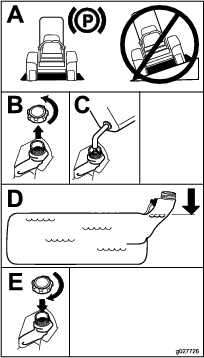
Checking the Engine-Oil Level
Before you start the engine and use the machine, check the oil level in the engine crankcase; refer to Checking the Engine-Oil Level.
Breaking in a New Machine
New engines take time to develop full power. Mower decks and drive systems have higher friction when new, placing additional load on the engine. Allow 40 to 50 hours of break-in time for new machines to develop full power and best performance.
Using the Rollover-Protection System (ROPS)
Warning
To avoid injury or death from rollover: keep the roll bar in the fully raised, locked position and use the seat belt.
Ensure that the seat is secured to the machine.
Warning
There is no rollover protection when the roll bar is in the down position.
-
Lower the roll bar only when absolutely necessary.
-
Do not wear the seat belt when the roll bar is in the down position.
-
Drive slowly and carefully.
-
Raise the roll bar as soon as clearance permits.
-
Check carefully for overhead clearances (i.e., branches, doorways, electrical wires) before driving under any objects, and do not contact them.
Important: Ensure that the seat is secured to the machine.
-
To lower the roll bar, apply forward pressure to the upper part of the roll bar.
-
Pull both knobs out and rotate them 90 degrees so they are not engaged (Figure 7).
-
Lower the roll bar to the down position (Figure 7).

-
To raise the roll bar, raise the roll bar to the operate position and rotate the knobs so that they move partially into the grooves (Figure 7).
-
Raise the roll bar to the full upright position while pushing on the upper roll bar so that the pins snap into position when the holes align with the pins (Figure 7).
-
Push on the roll bar and ensure that both pins are engaged.
Important: Always use the seat belt with the roll bar in the raised position.
Think Safety First
Please read all safety instructions and symbols in the safety section. Knowing this information could help you or bystanders avoid injury.
Danger
Operating the machine on wet grass or steep slopes can cause sliding and loss of control.
-
Do not operate on slopes greater than 15 degrees.
-
Reduce speed and use extreme caution on slopes.
-
Do not operate the machine near water.
Danger
Wheels dropping over edges can cause rollovers, which may result in serious injury, death, or drowning.
Do not operate the machine near drop-offs.
Danger
Operating the machine while the roll bar is down may lead to serious injury or death in the event of a rollover.
Always keep the roll bar in the fully raised and locked position and use the seat belt.
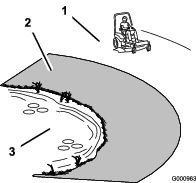
Caution
This machine produces sound levels in excess of 85 dBA at the operator's ear and can cause hearing loss through extended periods of exposure.
Wear hearing protection when operating this machine.
The use of protective equipment for eyes, ears, hands, feet, and head is recommended.

Operating the Parking Brake
Always set the parking brake when you stop the machine or leave it unattended.
Setting the Parking Brake
Warning
The parking brake may not hold a machine parked on a slope and could cause personal injury or property damage.
Do not park the machine on slopes unless the wheels are chocked or blocked.
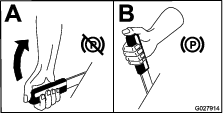
Releasing the Parking Brake
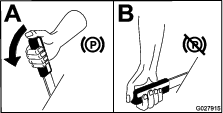
Operating the Mower Blade-Control Switch (PTO)
The blade-control switch (PTO) starts and stops the mower blades and any powered attachments.
Engaging the Blade-Control Switch (PTO)
Note: Engaging the blade-control switch (PTO) with the throttle position at half or less causes excessive wear to the drive belts.
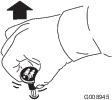
Disengaging the Blade-Control Switch (PTO)

Operating the Throttle
You can move the throttle control between FAST and SLOW positions (Figure 14).
Always use the FAST position when turning on the mower deck with the blade-control switch (PTO).

Operating the Choke
Use the choke to start a cold engine.
-
If the engine is cold, use the choke to start the engine.
-
Pull up the choke knob to engage the choke before using the ignition switch (Figure 15).
-
Push down the choke knob to disengage the choke after starting the engine (Figure 15).

Operating the Ignition Switch
-
Turn the ignition key to the START position (Figure 16).
Note: When the engine starts, release the key.
Important: Do not engage the starter for more than 5 seconds at a time. If the engine fails to start, wait 15 seconds between attempts. Failure to follow these instructions can burn out the starter motor.
Note: You may need multiple attempts to start the engine when you start it the first time after the fuel system has been without fuel completely.
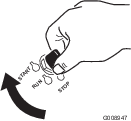
-
Turn the ignition key to the STOP position to stop the engine.
Using the Fuel-Shutoff Valve
The fuel-shutoff valve is located behind the seat.
Close the fuel-shutoff valve for transport, maintenance, and storage.
Ensure that the fuel-shutoff valve is open when starting the engine.


Starting and Stopping the Engine
Starting the Engine
-
Raise the ROPS up, lock it into place, sit on the seat, and fasten the seat belt.
-
Move the motion controls to NEUTRAL-LOCK position.
-
Set the parking brake; refer to Setting the Parking Brake.
-
Move the blade-control switch (PTO) to the OFF position (Figure 13).
-
Move the throttle lever midway between the SLOW and FAST positions.
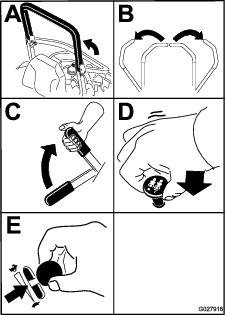
-
Turn the ignition key to the START position (Figure 19).
Note: When the engines starts, release the key.
Important: Do not engage starter for more than 5 seconds at a time. If the engine fails to start allow a 15 second cool-down period between attempts. Failure to follow these instructions can burn out the starter motor.
Note: You may need to attempt to start the engine multiple times when you start it for the first time after the fuel system has been without fuel completely.

Stopping the Engine
Caution
Children or bystanders may be injured if they move or attempt to operate the machine while it is unattended.
Always remove the ignition key and set the parking brake when leaving the machine unattended, even if just for a few minutes.
Let the engine idle at slow throttle (turtle) for 60 seconds before turning the ignition switch off.
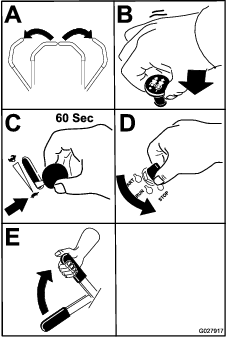
Important: Make sure that the fuel-shutoff valve is closed before transporting or storing the machine, as fuel leakage may occur. Set the parking brake before transporting. Make sure to remove the key as the fuel pump may run and cause the battery to lose charge.
Using the Safety-Interlock System
Caution
If the safety-interlock switches are disconnected or damaged, the machine could operate unexpectedly, causing personal injury.
-
Do not tamper with the interlock switches.
-
Check the operation of the interlock switches daily and replace any damaged switches before operating the machine.
Understanding the Safety-Interlock System
The safety-interlock system is designed to prevent the engine from starting unless:
-
The parking brake is engaged.
-
The blade-control switch (PTO) is disengaged.
-
The motion-control levers are in the NEUTRAL-LOCK position.
The safety-interlock system also is designed to stop the engine when you move the traction controls from the locked position with the parking brake engaged or if you rise from the seat when the PTO is engaged.
Testing the Safety-Interlock System
| Maintenance Service Interval | Maintenance Procedure |
|---|---|
| Before each use or daily | |
Test the safety-interlock system before you use the machine each time. If the safety system does not operate as described below, have an Authorized Service Dealer repair the safety system immediately.
-
Sit on the seat, engage the parking brake and move the blade-control switch (PTO) to the ON position. Try starting the engine; the engine should not crank.
-
Sit on the seat, engage the parking brake and move the blade-control switch (PTO) to the OFF position. Move either motion-control lever (out of the NEUTRAL-LOCK position). Try starting the engine; the engine should not crank. Repeat for other control lever.
-
Sit on the seat, engage the parking brake, move the blade-control switch (PTO) to the OFF position, and move the motion-control levers to the NEUTRAL-LOCK position. Start the engine. While the engine is running, release the parking brake, engage the blade-control switch (PTO), and rise slightly from the seat; the engine should stop.
-
Sit on the seat, engage the parking brake, move the blade-control switch (PTO) to the OFF position, and move the motion-control levers to NEUTRAL-LOCK position. Start the engine. While the engine is running, center either motion-control lever and move it forward or reverse; the engine should stop. Repeat for other motion-control lever.
-
Sit on the seat, disengage the parking brake, move the blade-control switch (PTO) to the OFF position, and move the motion-control levers to NEUTRAL-LOCK position. Try starting the engine; the engine should not crank.
Driving Forward or Backward
The throttle control regulates the engine speed as measured in rpm (revolutions per minute). Place the throttle control in the FAST position for best performance. Always operate in the full throttle position when mowing.
Caution
Machine can spin very rapidly. You may lose control of machine and injure yourself or damage the machine.
-
Use caution when making turns.
-
Slow the machine down before making sharp turns.
Using the Motion-Control Levers

Driving Forward
Note: The engine shuts off if you move the traction-control levers with the parking brake engaged.
To stop, pull the motion-control levers to the NEUTRAL position.
-
Release the parking brake; refer to Releasing the Parking Brake.
-
Move the levers to the center, unlocked position.
-
To go forward, slowly push the motion-control levers forward (Figure 22).
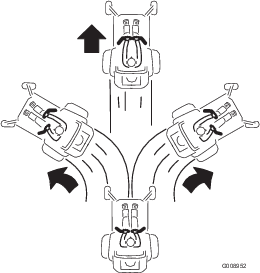
Driving Backward
-
Move the levers to the center, unlocked position.
-
To go backward, slowly pull the motion-control levers rearward (Figure 23).
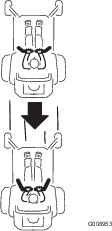
Stopping the Machine
To stop the machine, move the motion-control levers to neutral and then to the NEUTRAL-LOCK position, disengage the blade-control switch (PTO), and turn the ignition key to the OFF position.
Set the parking brake when you leave the machine; refer to Setting the Parking Brake. Remove the key from the ignition switch.
Caution
Children or bystanders may be injured if they move or attempt to operate the machine while it is unattended.
Always remove the ignition key and set the parking brake when leaving the machine unattended, even if just for a few minutes.
Adjusting the Height-of-Cut
Using the Transport Lock
The transport lock has 2 positions, and is used with the deck-lift pedal. There is a LOCK position and an UNLOCK position for the transport position of the mower deck (Figure 24).
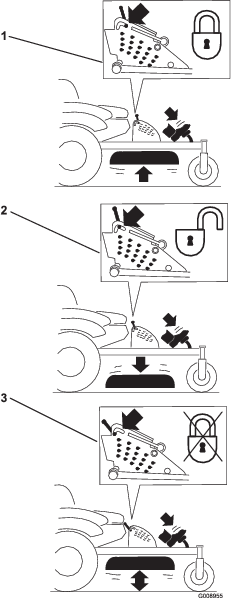
Adjusting the Height-of-Cut Pin
| Mower deck size | Height-of-cut range | Increments |
| 48-inch deck | 38 to 127 mm (1-1/2 to 5 inches) | 6 mm (1/4 inch) |
| 52-inch and 60-inch decks | 38 to 140 mm (1-1/2 to 5-1/2 inches) | 6 mm (1/4 inch) |
Adjust the height-of-cut from 25 to 140 mm (1 to 5-1/2 inches) in 6 mm (1/4 inch) increments by moving the clevis pin into different hole locations.
-
Move the transport lock to the LOCK position.
-
Push on the deck-lift pedal with your foot and raise the mower deck to the Transport position (also the 140 mm or 5-1/2 inch cutting-height position) as shown in Figure 25.
-
To adjust, rotate the pin 90 degrees and remove the pin from the height-of-cut bracket (Figure 25).
-
Select a hole in the height-of-cut bracket corresponding to the height-of-cut desired, and insert the pin (Figure 25).
-
Push on the deck lift, pull back on the transport lock, and slowly lower the mower deck.
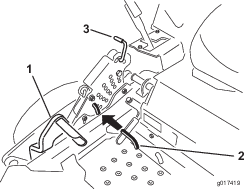
Adjusting the Anti-Scalp Rollers
Whenever you change the height-of-cut, adjust the height of the anti-scalp rollers.
-
Disengage the blade-control switch (PTO), move the motion-control levers to the NEUTRAL-LOCK position, and set the parking brake.
-
Stop the engine, remove the key, and wait for all moving parts to stop before leaving the operating position.
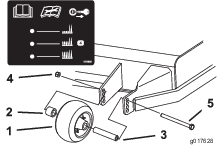
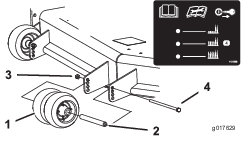
Positioning the Seat
The seat can move forward and backward. Position the seat where you have the best control of the machine and are most comfortable.
To adjust the seat, move the lever sideways to unlock the seat (Figure 28).
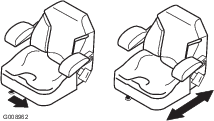
Using the Drive-Wheel-Release Valves
Warning
Hands may become entangled in the rotating drive components below the engine deck, which could result in serious injury.
Stop the engine, remove the key, and allow all moving parts to stop before accessing the drive-wheel-release valves.
Warning
The engine and hydraulic-drive units can become very hot. Touching a hot engine or hydraulic-drive units can cause severe burns.
Allow the engine and hydraulic-drive units to cool completely before accessing the drive-wheel-release valves.
The drive-wheel-release valves are located behind the seat and down in the engine compartment.
-
Disengage the blade-control switch (PTO), turn the ignition key to off, move the levers to the NEUTRAL-LOCK position, apply the parking brake, and remove the key.
-
Locate the bypass levers behind the seat, down on the left and right side of the frame.
-
To push the machine, move both bypass levers rearward and out to lock them into place (Figure 29).
-
Disengage the parking brake before pushing the machine.
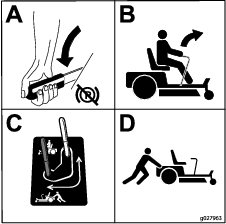
-
To run the machine, move the bypass levers to the FORWARD position (Figure 29).
Using the Side Discharge
The mower has a hinged grass deflector that disperses clippings to the side and down toward the turf.
Danger
Without a grass deflector, discharge cover, or a complete grass-catcher assembly mounted in place, you and others are exposed to blade contact and thrown debris. Contact with rotating mower blade(s) and thrown debris cause injury or death.
-
Never remove the grass deflector from the mower because the grass deflector routes material down toward the turf. If the grass deflector is ever damaged, replace it immediately.
-
Never put your hands or feet under the mower.
-
Never try to clear the discharge area or mower blades unless you move the blade-control switch (PTO) to the OFF position, rotate the ignition key to the OFF position, and remove the key.
-
Make sure that the grass deflector is in the down position.
Transporting the Machine
Use a heavy-duty trailer or truck to transport the machine. Ensure that the trailer or truck has all necessary brakes, lighting, and marking as required by law. Please carefully read all the safety instructions. Knowing this information could help you, your family, pets, or bystanders avoid injury.
Warning
Driving on the street or roadway without turn signals, lights, reflective markings, or a slow-moving-vehicle emblem is dangerous and can lead to accidents, causing personal injury.
Do not drive the machine on a public street or roadway.
To transport the machine:
-
If you are using a trailer, connect it to the towing vehicle and connect the safety chains.
-
If applicable, connect the trailer brakes.
-
Load the machine onto the trailer or truck.
-
Stop the engine, remove the key, set the brake, and close the fuel valve.
-
Use the metal tie-down loops on the machine to securely fasten the it to the trailer or truck with straps, chains, cable, or ropes (Figure 30).
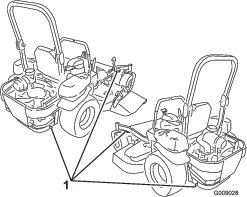
Loading the Machine
Use extreme caution when loading or the unloading machine onto a trailer or a truck. Use a full-width ramp that is wider than the machine for this procedure. Back the machine up the ramps and drive it forward down the ramps (Figure 31).

Important: Do not use narrow individual ramps for each side of the machine.
Ensure that the ramp is long enough so that the angle with the ground does not exceed 15 degrees (Figure 32). On flat ground, this requires a ramp to be at least 4 times as long as the height of the trailer or truck bed to the ground. A steeper angle may cause mower components to get caught as the machine moves from the ramp to the trailer or truck. Steeper angles may also cause the machine to tip or lose control. If you are loading the machine on or near a slope, position the trailer or truck so that it is on the down side of the slope and the ramp extends up the slope. This minimizes the ramp angle.
Warning
Loading a machine onto a trailer or truck increases the possibility of a tip-over and could cause serious injury or death.
-
Use extreme caution when operating a machine on a ramp.
-
Ensure that the ROPS is in the up position and use the seat belt when loading or unloading the machine. Ensure that the ROPS clears the top of an enclosed trailer.
-
Use only a full-width ramp; do not use individual ramps for each side of the machine.
-
Do not exceed a 15-degree angle between the ramp and the ground or between the ramp and the trailer or truck.
-
Ensure that the length of ramp is at least 4 times as long as the height of the trailer or truck bed to the ground. This ensures that ramp angle does not exceed 15 degrees on flat ground.
-
Back the machine up the ramps and drive it forward down the ramps.
-
Avoid sudden acceleration or deceleration while driving the machine on a ramp as this could cause a loss of control or a tip-over.
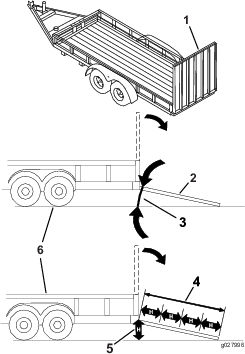
Operating Tips
Using the Fast Throttle Setting
For best mowing and maximum air circulation, operate the engine at the FAST throttle position. Air is required to thoroughly cut grass clippings, so do not set the height-of-cut so low as to totally surround the mower by uncut grass. Always try to have 1 side of the mower free from uncut grass, which allows air to be drawn into the mower.
Cutting a Lawn for the First Time
Cut grass slightly longer than normal to ensure that the cutting height of the mower does not scalp any uneven ground. However, the cutting height you have used in the past is generally the best 1 to use. When cutting grass longer than 15.24 cm (6 inches) tall, you may want to cut the lawn twice to ensure an acceptable quality of cut.
Cutting a Third of the Grass Blade
It is best to cut only about 1/3 of the grass blade. Cutting more than that is not recommended unless grass is sparse, or it is late fall when grass grows more slowly.
Alternating the Mowing Direction
Alternate the mowing direction to keep the grass standing straight. This also helps disperse clippings, which enhances decomposition and fertilization.
Mowing at Correct Intervals
Normally, mow every 4 days. However, grass grows at different rates at different times. To maintain the same cutting height, which is a good practice, mow more often in early spring. As the grass growth rate slows in mid-summer, mow less frequently. If you cannot mow for an extended period, first mow at a high cutting height; then mow again 2 days later at a lower height setting.
Adjusting the Cutting Speed
To improve cut quality, use a slower ground speed in certain conditions.
Avoiding Cutting Too Low
If the cutting width of the mower is wider than the mower that you previously used, raise the cutting height to ensure that uneven turf is not cut too short.
Cutting Long Grass
If the grass is ever allowed to grow slightly longer than normal, or if it contains a high degree of moisture, raise the cutting height higher than usual and cut the grass at this setting. Then cut the grass again using the lower, normal setting.
Stopping
If you must stop the forward motion of the machine while mowing, a clump of grass clippings may drop onto your lawn. To avoid this, move onto a previously cut area with the blades engaged.
Keeping the Underside of the Mower Clean
Clean clippings and dirt from the underside of the mower after each use. If grass and dirt build up inside the mower, the cutting quality eventually becomes unsatisfactory.
Maintaining the Blade
Maintain a sharp blade throughout the cutting season, because a sharp blade cuts cleanly without tearing or shredding the grass blades. Tearing and shredding turns grass brown at the edges, which slows growth and increases the chance of disease. Check the cutter blades daily for sharpness and for any wear or damage. File down any nicks and sharpen the blades as necessary. If a blade is damaged or worn, replace it immediately with a genuine Toro replacement blade.
Source: https://manuals.toro.com/143612/index.html
0 Response to "Easy Way to Get My Key Switch Working on My 2004 Toro 147 Zmaster"
Post a Comment